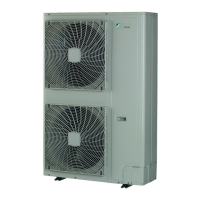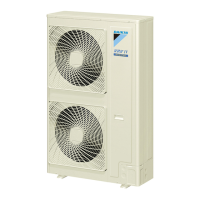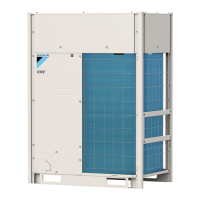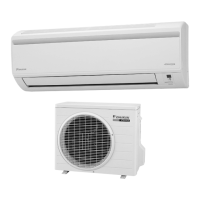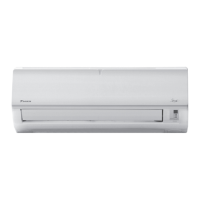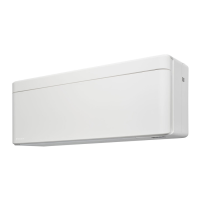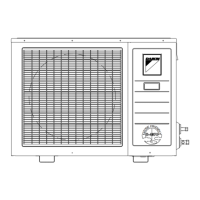14 Piping installation
Installation and operation manual
32
SV1A25AJV1B+SV4~8A14AJV1B
VRV 5 safety valve unit
4P709466-1 – 2023.09
Ambient
temperature
Humidity Minimum thickness
>30°C ≥80% RH 20mm
14.3 Connecting the refrigerant piping
DANGER: RISK OF BURNING/SCALDING
14.3.1 To connect the refrigerant piping
a SV unit
b Liquid pipe (field supply)
c Gas pipe (field supply)
d Reducing joints and insulation tubes (accessory)
e Indoor unit connection set
f Liquid pipe (field supply)
g Gas pipe (field supply)
WARNING
Bent header or branch pipes can lead to refrigerant
leakage. Possible consequence: asphyxiation,
suffocation and fire.
▪ NEVER bend the branch and header pipes sticking out
of the unit. They have to remain straight.
▪ ALWAYS support the branch and header pipes at a
distance of 1m from the unit.
Prerequisite: Mount the indoor, outdoor and SV units.
Prerequisite: Read the instructions in the outdoor unit's manual for
information on how to install piping between the outdoor unit and the
SV unit, selecting a refrigerant branch kit, and installing piping
between the refrigerant branch kit and the SV units.
Prerequisite: Read the instructions in the indoor unit's manual for
information on how to install piping between the indoor unit and the
SV unit.
Prerequisite: When connecting piping, respect the guidelines for
pipe bending and brazing.
1 Connect the header pipes to the appropriate field supply pipes.
Use a reducing joint (accessory) if the field supply pipe size
does not match the header pipe size of the SV unit. The
diameters of the header pipes of the SV unit are:
▪ Liquid pipe: 15.9mm
▪ Gas pipe: 22.2mm
2 If necessary, cut the branch pipes as indicated in the illustration
below. The diameters of the branch pipes of the SV unit are
indicated in the illustration.
c
d
b
a
Ø
6.35
mm
Ø
9.5
mm
Ø
12.7
mm
Ø
15.9
mm
Ø
9.5
mm
a Liquid branch pipe
b Gas branch pipe
c Liquid header pipe
d Gas header pipe
3 Connect the branch pipes. The liquid and gas branch pipe
diameters to be used depend on the connected indoor unit
capacity class. For information on which branch pipes to
connect, see "To set the DIP switches when joining branch pipe
ports"[436].
4 Install stopper pipes (accessory) for unused header pipes
(when the SV unit is not connected in refrigerant flow-through
with another SV unit) and unused branch pipes (when no indoor
unit is connected to that branch pipe port).
14.3.2 Joining branch pipe ports
To make a connection with e.g. FXMA200A and FXMA250A, join
branches with joint kit EKBSJK. Only the following combinations are
possible. E.g.: it is not possible to join ports B and C.
Note: When using the joint kit, change the DIP switch settings. See
"15.5To set the DIP switches"[436].
Model Possible port combinations
SV4A A+B C+D
SV6A E+F
SV8A G+H
14.4 To insulate the refrigerant piping
After finishing the leak test and vacuum drying, the piping must be
insulated. Take into account the following points:
To insulate stopper pipes
In case of stopper pipes: install stopper pipe insulation tubes
(accessory). Adding additional insulation might be required
depending on the ambient conditions. Follow the rules for the total
minimum insulation thickness.
1 Attach an insulation tube against the tube on the SV unit.
2 Apply a tape to close the seam so that air does not enter.
a Insulation tube (accessory)
b Cut surface (branch pipes only)
c Tape (field supply)
d Insulation tube (attached to the SV unit)
e SV unit
f Adherence surface
To insulate the header and branch pipes (standard insulation)
The header pipes and branch pipes MUST be insulated (field
supply). Make sure that the insulation is properly mounted over the
header and branch pipes of the unit as shown in the image below.
Always use tape (field supply) to prevent air gaps in the seam
between the insulation tubes.
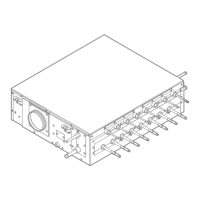
